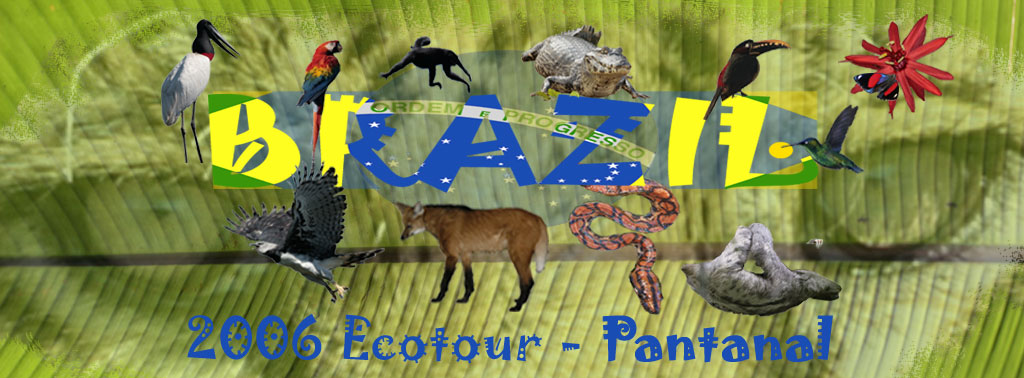



Added 3 September 2006
Day 8: Tueday, June 13, 2006
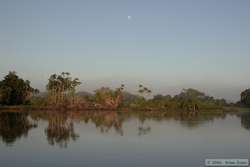 We had a change from our usual six a.m. breakfast and 6:30 a.m. start time as we had a lot of miles to cover for the day.
We had a change from our usual six a.m. breakfast and 6:30 a.m. start time as we had a lot of miles to cover for the day. 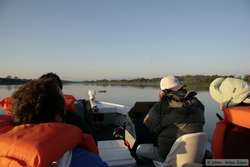 This time we started at 5:30 to get down the river. Our primary target for the day was the elusive Panthera onca, the jaguar, and to achieve our goal, we traveled down stream to the Taiama Reserve, run by IBAMA, which from what I gather is equivalent to the National Parks Service. As we continued down river, the water level had not dropped as much as near Hotel Baizinha, I surmised because the watershed was still draining, so there was some concern about being able to see a jaguar. We had an ace in the hole though. Due to the great distance we had to travel that day, we were scheduled to be gone all day, probably not returning until dinner time. However, Brazil was playing Croatia in the World Cup at three o'clock that afternoon.
This time we started at 5:30 to get down the river. Our primary target for the day was the elusive Panthera onca, the jaguar, and to achieve our goal, we traveled down stream to the Taiama Reserve, run by IBAMA, which from what I gather is equivalent to the National Parks Service. As we continued down river, the water level had not dropped as much as near Hotel Baizinha, I surmised because the watershed was still draining, so there was some concern about being able to see a jaguar. We had an ace in the hole though. Due to the great distance we had to travel that day, we were scheduled to be gone all day, probably not returning until dinner time. However, Brazil was playing Croatia in the World Cup at three o'clock that afternoon. 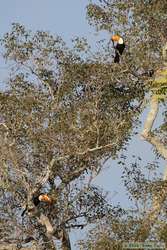 We told Fabricio and Indio that if they found us a jaguar, we would return to the hotel in time for them to watch the game.
We told Fabricio and Indio that if they found us a jaguar, we would return to the hotel in time for them to watch the game. 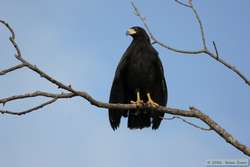 If there was anything that would get a Brazilian to find something for you fast, it's giving them hope to watch Brazil win another World Cup game.
If there was anything that would get a Brazilian to find something for you fast, it's giving them hope to watch Brazil win another World Cup game.
One of our early sights was a black-fronted nunbird, which turned into a mildly comical situation. None of us could quite understand what Fabricio was saying, but wrote down the name of the bird as we thought he said it. Comparing notes later, I had written down "thumb-bird” and Chuck had written down "numb-bird”. Perhaps Dave, the most knowledgeable birder among us, got it right.
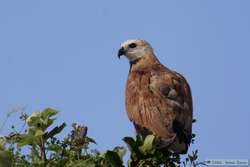
|
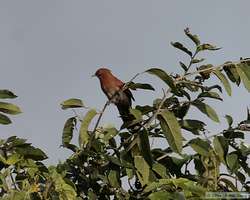
|
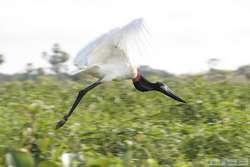
|
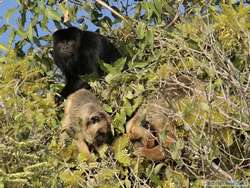
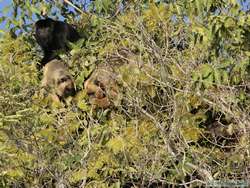 We traveled quickly, stopping occasionally to talk to a Pantaniero or someone on a houseboat to see if they had seen any jaguar. The Pantaniero that we had spoken with the previous day said he regularly sees one right at his shack, and that it was there last night, but couldn't help us locate one at present.
We traveled quickly, stopping occasionally to talk to a Pantaniero or someone on a houseboat to see if they had seen any jaguar. The Pantaniero that we had spoken with the previous day said he regularly sees one right at his shack, and that it was there last night, but couldn't help us locate one at present.
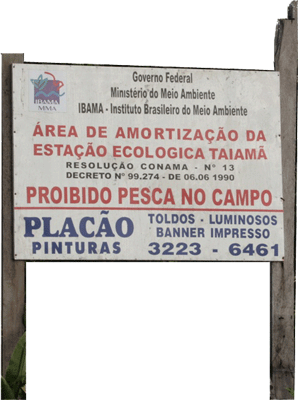 When we reached the Taiama Reserve, we found the water level to be quite high, with absolutely no beaches in the area we were in.
When we reached the Taiama Reserve, we found the water level to be quite high, with absolutely no beaches in the area we were in. 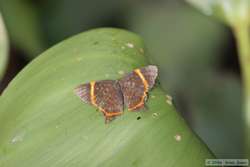 It was obvioius right away that we would see no jaguar there. Even though the area looked like it was completely flat, we were surprised by the rather strong currents in the open areas between the vegetation. When combined with the narrow confines of the open channels, the currents allowed Indio to prove his fantastic boating skills.
It was obvioius right away that we would see no jaguar there. Even though the area looked like it was completely flat, we were surprised by the rather strong currents in the open areas between the vegetation. When combined with the narrow confines of the open channels, the currents allowed Indio to prove his fantastic boating skills.
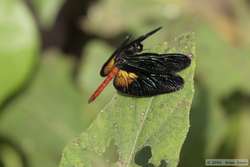 The area was largely devoid of large trees, and was composed primarily of low aquatic vegetation as far as the eye could see. And when standing up in the boat, it was possible to see quite a ways. I remained fascinated by the flow of the water itself, as well as the sheer immensity of the place, but it was obvious that we wouldn't see much in the way of wildlife. We found a few birds, but little else.
The area was largely devoid of large trees, and was composed primarily of low aquatic vegetation as far as the eye could see. And when standing up in the boat, it was possible to see quite a ways. I remained fascinated by the flow of the water itself, as well as the sheer immensity of the place, but it was obvious that we wouldn't see much in the way of wildlife. We found a few birds, but little else.
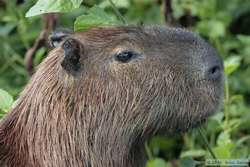
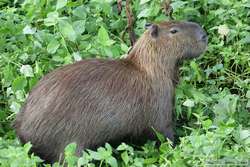 Then we saw a capybara (Hydrochaeris hydrochaeris) in the thick water plants, which was a nice treat. We would eventually see a fair number of capybara throughout the day. Capybaras are the largest rodents in the world, weighing in at up to 65 kg (140 lbs). At that size, capybara is nice jaguar food, as are many things of course, even the caiman. One of the few things the jaguar don't eat are the brazilian tapirs (Tapirus terrestris), which at 300 kg (660 pounds) are so large and maniacal that when a jaguar jumps on a tapirs back, the tapir will take off like mad through the bush, eventually throwing the jaguar off.
Then we saw a capybara (Hydrochaeris hydrochaeris) in the thick water plants, which was a nice treat. We would eventually see a fair number of capybara throughout the day. Capybaras are the largest rodents in the world, weighing in at up to 65 kg (140 lbs). At that size, capybara is nice jaguar food, as are many things of course, even the caiman. One of the few things the jaguar don't eat are the brazilian tapirs (Tapirus terrestris), which at 300 kg (660 pounds) are so large and maniacal that when a jaguar jumps on a tapirs back, the tapir will take off like mad through the bush, eventually throwing the jaguar off.
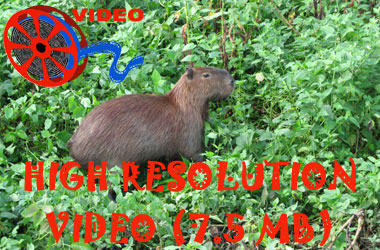
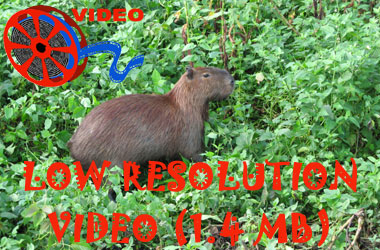
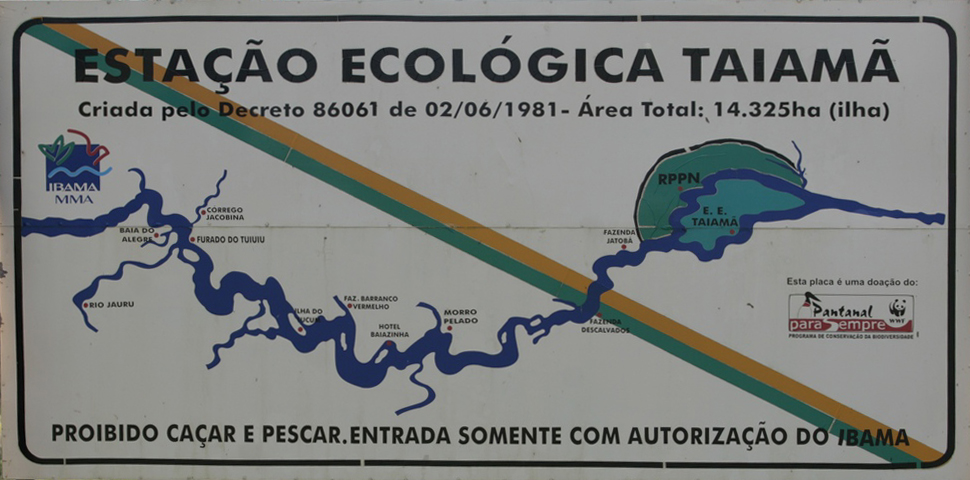
I have no idea what the scale on the above map is, but Hotel Baizinha and the Taiama Preserve are both on it.
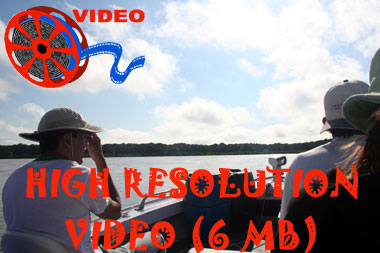
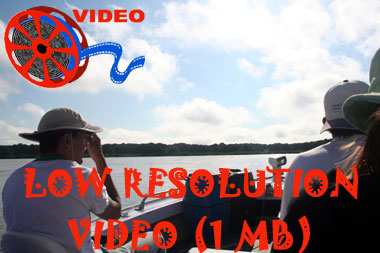 It was pretty obvious that we weren't going to see much in the area we found ourselves in, so we motored back out to the river, with Indio whipping the boat through the narrow, twisting channel at thrilling speed. As we reached the preserve boundary, we encountered a handful of fishing boats just inside the preserve boundary. It's illegal to fish within Taiama, and when we came screaming around the corner, the fisherman thought we were law enforcement and started scattering. We didn't realize exactly what was going on at the time, but when Fabricio explained why they were moving away from us, we all thought it was pretty funny. Too bad we didn't have a way to scare them a little more.
It was pretty obvious that we weren't going to see much in the area we found ourselves in, so we motored back out to the river, with Indio whipping the boat through the narrow, twisting channel at thrilling speed. As we reached the preserve boundary, we encountered a handful of fishing boats just inside the preserve boundary. It's illegal to fish within Taiama, and when we came screaming around the corner, the fisherman thought we were law enforcement and started scattering. We didn't realize exactly what was going on at the time, but when Fabricio explained why they were moving away from us, we all thought it was pretty funny. Too bad we didn't have a way to scare them a little more.
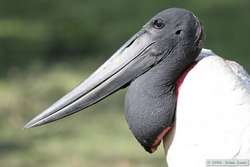 Back on the main river, we saw more in the way of wildlife.
Back on the main river, we saw more in the way of wildlife. 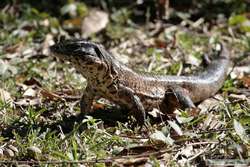 We continued down the river, stopping here and there to investigate something interesting. We saw plenty of Capybara. We stopped at what was basically a ranger station for the reserve, where we all got out to get permission to enter the Preserve, I'm sure a mere formality. It gave us a chance to walk around a bit though, which was nice.
We continued down the river, stopping here and there to investigate something interesting. We saw plenty of Capybara. We stopped at what was basically a ranger station for the reserve, where we all got out to get permission to enter the Preserve, I'm sure a mere formality. It gave us a chance to walk around a bit though, which was nice.
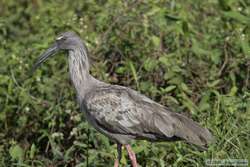
|
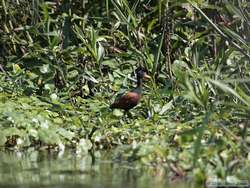
|

|
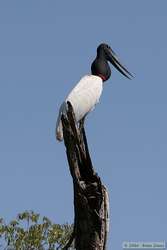
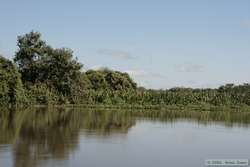 By late morning, we still didn't have our jaguar, and I didn't really hold out much hope. Shan too, that beacon of optimism that we would see one, also admitted that she didn't think we had a chance once she saw how high the water level was and as a result, how thickly vegetated the shore was.
By late morning, we still didn't have our jaguar, and I didn't really hold out much hope. Shan too, that beacon of optimism that we would see one, also admitted that she didn't think we had a chance once she saw how high the water level was and as a result, how thickly vegetated the shore was.
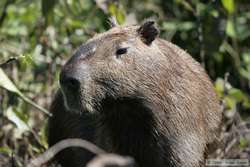 Still we contented ourselves with the search, and I further contented myself with amazement at the vastness and beauty of the Pantanal. It seemed unending, though I knew it wasn't, and even then realized how quickly it could all be destroyed if enough people didn't realize it's value in it's natural state. It wasn't long ago that a massive plan was hatched to increase the navigability of Rio Paraguai. The changes would surely have destroyed vast stretches of the Pantanal, as it would have severely reduced the amount of overland flooding that takes place and breathes life into the far reaches of the Pantanal, cutting off the natural cycle that created this natural wonder. This plan is apparently still not entirely dead, and those of us concerned about such things must remain diligent in preventing the plan from coming back to life.
Still we contented ourselves with the search, and I further contented myself with amazement at the vastness and beauty of the Pantanal. It seemed unending, though I knew it wasn't, and even then realized how quickly it could all be destroyed if enough people didn't realize it's value in it's natural state. It wasn't long ago that a massive plan was hatched to increase the navigability of Rio Paraguai. The changes would surely have destroyed vast stretches of the Pantanal, as it would have severely reduced the amount of overland flooding that takes place and breathes life into the far reaches of the Pantanal, cutting off the natural cycle that created this natural wonder. This plan is apparently still not entirely dead, and those of us concerned about such things must remain diligent in preventing the plan from coming back to life.
As we wandered around, we got to see some giant water lilies (Victoria amazonica, or something similar), an unexpected pleasure. I didn't think we would see any in the Pantanal. They are very impressive to see in person, even though I know that there are some even larger versions.
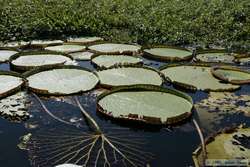
|
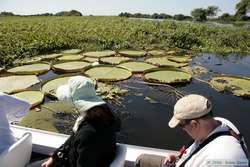
|
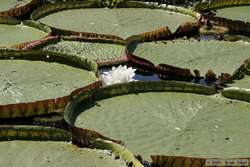
|
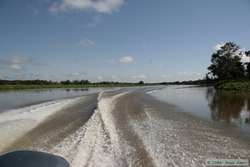 As noon approached, we started looking for a beach where we could eat lunch. Indio had the boat in high gear as we raced along waterways both large and small looking for someplace suitable. Apparently his standards were higher than mine. I was pretty hungry by that point, so was disappointed when we passed several "beaches" that, though small, I thought would have sufficed. But we motored on at a pretty good clip through the myriad waterways that is the Pantanal in high times. How Indio knew where to go was totally beyond me. And though I probably could have gotten us back to the hotel, I was sure happy that I wouldn't have to try!
As noon approached, we started looking for a beach where we could eat lunch. Indio had the boat in high gear as we raced along waterways both large and small looking for someplace suitable. Apparently his standards were higher than mine. I was pretty hungry by that point, so was disappointed when we passed several "beaches" that, though small, I thought would have sufficed. But we motored on at a pretty good clip through the myriad waterways that is the Pantanal in high times. How Indio knew where to go was totally beyond me. And though I probably could have gotten us back to the hotel, I was sure happy that I wouldn't have to try!
We rounded a bend a raced down a straight stretch when my eyes spotted the unmistakable spotted form of a jaguar (Panthera onca) lying low in the shoreline vegetation looking out over the water. I made to yell out and alert everyone of the discovery, but Indio was already in the process of spinning the boat around and Chuck and Dave were already reaching for their cameras. 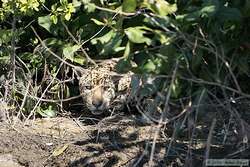 I whipped my head around to lengthen my viewing time of the jaguar but the momentum of the boat quickly drug us out of sight.
I whipped my head around to lengthen my viewing time of the jaguar but the momentum of the boat quickly drug us out of sight.
I knew that by the time we spun around and made it back to where the jaguar was, the wake of the boat would have smashed into the shore and sent the jaguar fleeing into the impenetrable (to me) vegetation. I think we all may have shared that same fear: our prized moment would be a fleeting one, as it most often is.
Perhaps bound by our extreme hope, but more likely out of sheer cat curiosity, the jaguar was still there when we returned, ducking low below the vegetation to get a less obstructed view of us as we approached. He made no hint at running and only craned his head as we drifted through his world, as if as transfixed by us as we were of him.
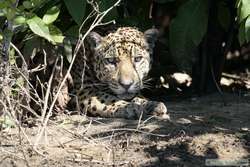
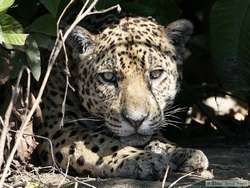 Certainly, in the expression of camera shutters clacking away, we were locked into that gaze. If not the eyes, then the spots, then eyes again. Indeed, I became so focused on the jaguar itself that I never once thought about the photos I was taking. It was just an extension of my eyes, capturing a moment that I knew could bolt away at any time.
Certainly, in the expression of camera shutters clacking away, we were locked into that gaze. If not the eyes, then the spots, then eyes again. Indeed, I became so focused on the jaguar itself that I never once thought about the photos I was taking. It was just an extension of my eyes, capturing a moment that I knew could bolt away at any time.
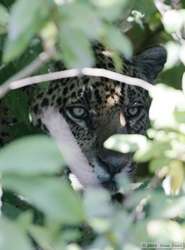 For this reason, as well as the overwhelming adrenaline coursing through my body, I never once thought about the settings I was using on my camera.
For this reason, as well as the overwhelming adrenaline coursing through my body, I never once thought about the settings I was using on my camera. 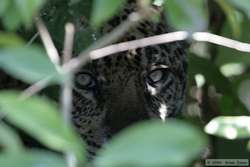 I'd had it set up for taking pictures of birds and Capybara in open sun. It was only by the grace of having a phenomenal lens that I got any decent pictures at all. Still, some came out pretty blurry. Another fundamental thought that would have been a great mental leap for me at the time was to zoom out and get a full body shot of him. At some point he rose and paced through the underbrush sizing us up, yet I kept focusing on his eyes.
I'd had it set up for taking pictures of birds and Capybara in open sun. It was only by the grace of having a phenomenal lens that I got any decent pictures at all. Still, some came out pretty blurry. Another fundamental thought that would have been a great mental leap for me at the time was to zoom out and get a full body shot of him. At some point he rose and paced through the underbrush sizing us up, yet I kept focusing on his eyes.
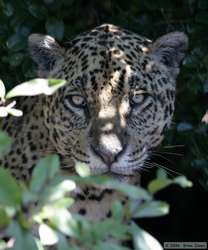 Only after he had returned to the small clearing and stood with head and shoulders into the thick vegetation did the thought take hold. Looking back, it seems almost an intentional act on his part.
Only after he had returned to the small clearing and stood with head and shoulders into the thick vegetation did the thought take hold. Looking back, it seems almost an intentional act on his part. 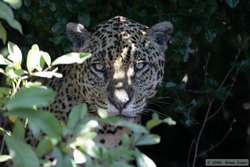 When he stood with his head in the brush, he didn't appear to be looking at us, so I have no explanation for why he stopped if not to say to me, "Look, there's more to me than meeting my eyes."
When he stood with his head in the brush, he didn't appear to be looking at us, so I have no explanation for why he stopped if not to say to me, "Look, there's more to me than meeting my eyes."
After a few moments there, he ducked down and slid off into the vast Pantanal. When, after a few silent moments, we were pretty certain the jaguar was not going to return for an encore, we congratulated ourselves with high-fives and back-slaps, as though we had won something through some monumental effort of our own doing. In truth, we had indeed won something. By the simple act of doggedly pursuing that one piece of the Pantanal, we had won a short but profound look into the eyes of Nature herself. Whole worlds float in the flecks of a jaguar's eyes, and we were close enough to see the entire cosmos residing there.
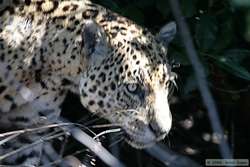
|
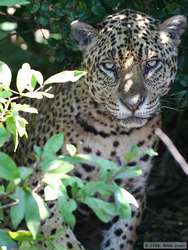
|
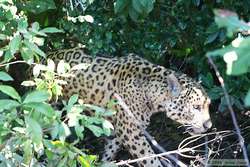
|
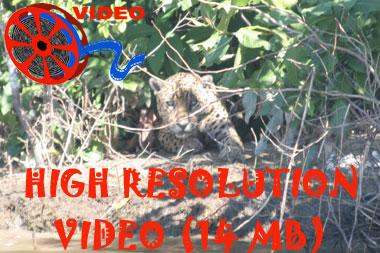
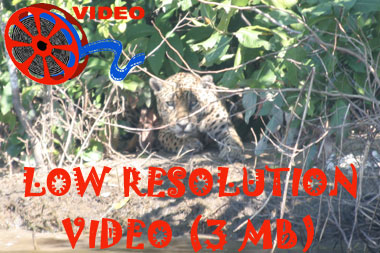 While creating this page, reliving the experience, once again I feel the thrill of looking that jaguar directly in the eye trying to absorb the moment. Looking at the pictures above gives me chills every time I see them.
While creating this page, reliving the experience, once again I feel the thrill of looking that jaguar directly in the eye trying to absorb the moment. Looking at the pictures above gives me chills every time I see them.
I often wonder if we might have been blessed enough to see another jaguar that day if we'd continued to explore the area, but we were true to our word, and raced home, with a little time to spare, to watch Brazil play Croatia in World Cup Play. Even I was somewhat torn between those two quintessentially Brazilian experiences.
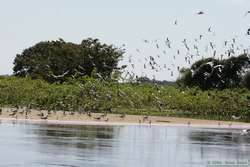
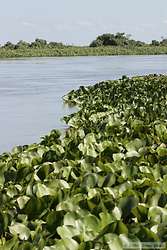 Along the way, we stopped a few times, when we came across something relatively rare, but otherwise, it was a race against time. We did make one other stop of note. Shan, whose bladder proved to be far more resilient than usual, finally could resist no more. There aren't a whole lot of places for a lady to relieve herself in the Pantanal when the waters are high. Those few pieces of relatively open ground are often places where animals such as caiman like to take up residence.
Along the way, we stopped a few times, when we came across something relatively rare, but otherwise, it was a race against time. We did make one other stop of note. Shan, whose bladder proved to be far more resilient than usual, finally could resist no more. There aren't a whole lot of places for a lady to relieve herself in the Pantanal when the waters are high. Those few pieces of relatively open ground are often places where animals such as caiman like to take up residence.
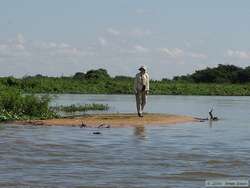
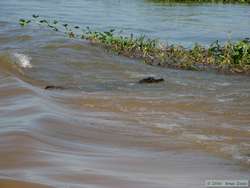 So it was with a certain amount of both fear and amusement that we motored up to a small nearly isolated patch of sand, evicting several caiman, and dropped Shan off to do Nature's business, with those same caiman still floating not too far from shore. (Note the small caiman in the water in the picture at left.) I was moderately surprised that she stepped off the boat, but I guess when you've got to go, you've got to go.
So it was with a certain amount of both fear and amusement that we motored up to a small nearly isolated patch of sand, evicting several caiman, and dropped Shan off to do Nature's business, with those same caiman still floating not too far from shore. (Note the small caiman in the water in the picture at left.) I was moderately surprised that she stepped off the boat, but I guess when you've got to go, you've got to go.
Once off the boat, we backed away and motored around the corner out of sight, though hopefully not out of earshot. We did our business over the side of the boat and returned to pick Shan up, we hoped whole and unharmed. When we rounded the corner, she was standing there eagerly awaiting our return. While we were gone, she had a bit of a scare. As she was peeing, she heard a woofing sound behind her. She thought it was a jaguar, but it was actually a caiman hiding nearby in vegetation. It was likely just making sure she knew he was there.
Though I joke, to defend my status as a good husband, I really didn't feel as though Shan was in any danger when we dropped her off. The caiman in the Pantanal are neither all that large nor very aggressive, and they are not known for attacking humans.
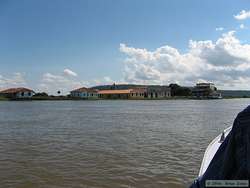
 We also stopped in at a small settlement of sorts on the main river so that Indio could fill the boat up with gas from the large fuel container he brought with us. Apparently, the settlement was part of an old ranch operation, complete with a slaughterhouse. It also had a neat little chapel nearby. It was quite a picturesque setting (with the exception of the slaughterhouse). We wandered around a bit and took pictures while Indio gassed the boat up, thinking that the place was completely deserted. But as we wandered around, someone came out of the large but decrepit house and started chatting with Indio.
We also stopped in at a small settlement of sorts on the main river so that Indio could fill the boat up with gas from the large fuel container he brought with us. Apparently, the settlement was part of an old ranch operation, complete with a slaughterhouse. It also had a neat little chapel nearby. It was quite a picturesque setting (with the exception of the slaughterhouse). We wandered around a bit and took pictures while Indio gassed the boat up, thinking that the place was completely deserted. But as we wandered around, someone came out of the large but decrepit house and started chatting with Indio.

|
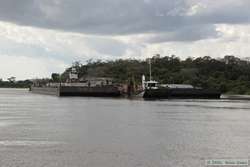
|
After leaving the ranch, we passed another barge hauling soy beans down the river to Argentina. The sight was strangely unsettling, and would become more so in time.
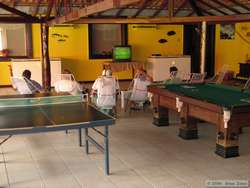 We made it back to Hotel Baizinha in time for the futbol game, and happily watched Brazil beat Croatia. I had expected everyone to be crowded around the television in the recreation area, so was surprised when it was only Chuck, Dave, Fabricio, Johnny and I there. Fabricio said they were watching the game on another television somewhere. I had hoped that everyone would be watching in the rec area to increase the sense of spirit of it all. I hope they didn't feel as though they had to watch someplace else away from us guests.
We made it back to Hotel Baizinha in time for the futbol game, and happily watched Brazil beat Croatia. I had expected everyone to be crowded around the television in the recreation area, so was surprised when it was only Chuck, Dave, Fabricio, Johnny and I there. Fabricio said they were watching the game on another television somewhere. I had hoped that everyone would be watching in the rec area to increase the sense of spirit of it all. I hope they didn't feel as though they had to watch someplace else away from us guests.
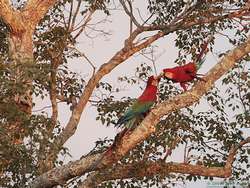 Towards the end of the game, Chuck lost interest and started wandering around. After the game, he located a pair of scarlet macaws (Ara macao) in a large tree some distance from the hotel.
Towards the end of the game, Chuck lost interest and started wandering around. After the game, he located a pair of scarlet macaws (Ara macao) in a large tree some distance from the hotel. 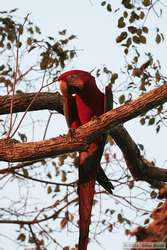 Shan wanted to go and get a closer look at them. I felt like being lazy, but got my camera gear and went with her. Fabricio came too, wearing only his flip-flops. I kept telling him he didn't have to come with us, especially when we got to a boggy section of the field we had to cross, but he did anyway. By then he must have known that Shan was likely to find some trouble and that he might be needed to get her out of it.
Shan wanted to go and get a closer look at them. I felt like being lazy, but got my camera gear and went with her. Fabricio came too, wearing only his flip-flops. I kept telling him he didn't have to come with us, especially when we got to a boggy section of the field we had to cross, but he did anyway. By then he must have known that Shan was likely to find some trouble and that he might be needed to get her out of it.
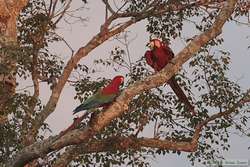 When we got to the macaw the sunlight was fading quickly, but I got a great look at them. Ironically the reddish evening sunlight, normally a photographers dream, gave the already red macaws an indistinct look.
When we got to the macaw the sunlight was fading quickly, but I got a great look at them. Ironically the reddish evening sunlight, normally a photographers dream, gave the already red macaws an indistinct look.
That evening we had more piranha soup before dinner, and after dinner hung out in the recreation area and played pool, ping pong, or just chatted.
Species list for the day (48 birds, 3 mammals, 2 reptiles, 1 amphibian, 1 fish):
Neotropic Cormorant (Phalacrocorax brasilianus)
Anhinga (Anhinga anhinga)
Southern Screamer (Chauna torquata)
Muscovy Duck (Cairina moschata)
Snowy Egret (Egretta thula)
Cocoi Heron (Ardea cocoi)
Great Egret (Ardea alba)
Cattle Egret (Bubulcus ibis)
Striated Heron (Butorides striatus)
Black-crowned Night-Heron (Nycticorax nycticorax)
Rufescent Tiger-Heron (Tigrisoma lineatum)
Bare-faced Ibis (Phimosus infuscatus)
Plumbeous Ibis (Theristicus caerulescens)
Roseate Spoonbill (Ajaia ajaja)
Wood Stork (Mycteria americana)
Jabiru (Jabiru mycteria)
Lesser Yellow-headed Vulture (Cathartes burrovianus)
M Snail Kite (Rostrhamus sociabilis)
Great Black-Hawk (Buteogallus urubitinga)
Savanna Hawk (Buteogallus meridionalis)
Black-collared Hawk (Busarellus nigricollis)
Bat Falcon (Falco rufigularis)
Wattled Jacana (Jacana jacana)
Pied Lapwing (Vanellus cayanus)
Southern Lapwing (Vanellus chilensis)
Black Skimmer (Rynchops niger)
Long-tailed Ground-Dove (Uropelia campestris)
Red-and-green Macaw (Ara chloropterus)
White-eyed Parakeet (Aratinga leucophthalmus)
Yellow-chevroned Parakeet (Brotogeris chiriri)
Squirrel Cuckoo (Piaya cayana)
Smooth-billed Ani (Crotophaga ani)
M Common Nighthawk (Chordeiles minor)
Buff-bellied Hermit (Phaethornis subochraceus)
Amazon Kingfisher (Chloroceryle amazona)
Green Kingfisher (Chloroceryle americana)
Rufous-tailed Jacamar (Galbula ruficauda)
Black-fronted Nunbird (Monasa nigrifrons)
Toco Toucan (Ramphastos toco)
Great Antshrike (Taraba major)
Common Tody-Flycatcher (Todirostrum cinereum)
Tropical Kingbird (Tyrannus melancholicus)
Silver-beaked Tanager (Ramphocelus carbo)
Yellow-billed Cardinal (Paroaria capitata)
Grayish Saltator (Saltator coerulescens)
Unicolored Blackbird (Agelaius cyanopus)
Yellow-rumped Cacique (Cacicus cela)
Solitary Cacique (Cacicus solitarius)
Black-and-gold Howler (Alouatta caraya)
Jaguar (Panthera onca onca)
Capybara (Hydrochaeris hydrochaeris)
Pantanal Caiman (Caiman yacare)
Golden Tegu lizard (Tupinambus teguixin)
Geckos (Family Gekkonidae )
Piranha
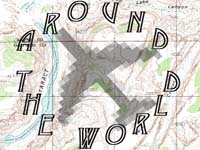 |
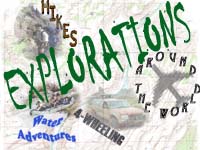 |